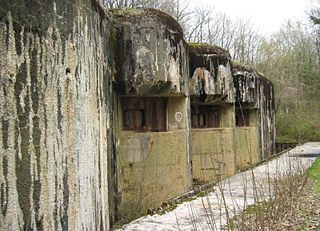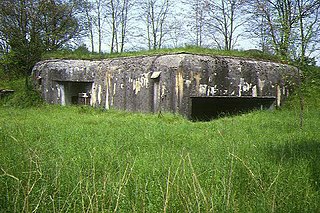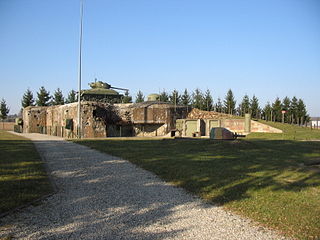
The Casemate de Rountzenheim Nord is a casemate of interval infantry of the Maginot Line. The casemate is in the town of Rœschwoog in France, behind the camping site, in the north of the railway.

Ouvrage Schoenenbourg is a Maginot Line fortification. It is located on the territory of the communes of Hunspach, Schœnenbourg and Ingolsheim, in the French département of Bas-Rhin, forming part of the Fortified Sector of Haguenau, facing Germany. At the east end of the Alsace portion of the Maginot Line, its neighbour is the gros ouvrage Hochwald. It is the largest such fortification open to the public in Alsace. Officially recorded as an historical monument, it retains all its original structural elements. Schoenenbourg was heavily bombarded during the Battle of France in 1940, receiving more enemy ordnance than any other position in France, with no significant damage. In 1945, retreating German troops used explosives to destroy much of the ouvrage. After the war it was fully repaired and placed back into service as part of a programme to use Maginot fortifications to resist a potential Warsaw Pact advance through Europe. By the 1970s the plan had lost favour and funding, and Schoenenboug was abandoned. In 1987 a local organisation undertook Schoenenbourg's preservation, and today it is open to public visitation.

Ouvrage Latiremont is a gros ouvrage of the Maginot Line, located in the Fortified Sector of the Crusnes, sub-sector of Arrancy. It lies between the gros ouvrage Fermont and the petit ouvrage Mauvais Bois, facing Belgium. The village of Doncourt-Cités is nearby. Latiremont was active in 1939-1940, coming under direct attack in late June 1940. It surrendered to German forces on 27 June. After renovations during the Cold War, it was abandoned.

The Casemate de Rountzenheim Sud is an interval infantry casemate of the Maginot Line. The casemate is in the town of Rœschwoog in France, behind the campsite, to the south of the railway.

Ouvrage Hochwald is a gros ouvrage of the Maginot Line, one of the largest fortifications in the Line. Located on the Hochwald ridge in the Fortified Sector of Haguenau in the community of Drachenbronn-Birlenbach in the Bas-Rhin department of northeastern France, it was designed to protect the northern Vosges region of France. Ouvrage Hochwald is sometimes considered as two ouvrages because of its separation of the western and the eastern portions of the ouvrage. Uniquely, the original plans for the position included an elevated battery to the rear with long-range 145 mm or 155 mm gun turrets of a new kind. Hochwald is used by the French Air Force as an armoured air defense coordination center.

Ouvrage Einseling is a lesser work of the Maginot Line. Located in the Fortified Sector of Faulquemont, the ouvrage consists of one infantry block, and is located between petits ouvrages Bambesch and Laudrefang, facing Germany. Einseling faced a determined German attack on 21 June 1940, during the Battle of France. Unlike its less fortunate neighbors to the west, Einseling was able to resist the attack with help from Laudrefang, its neighbor to the east. The ouvrage survives in a heavily battered state, with its lower levels flooded.

Ouvrage Aumetz is a small work, or petit ouvrage of the Maginot Line. It is part of the Fortified Sector of the Crusnes and is located near the community of Aumetz in the Moselle département of France. The petit ouvrage flanked by the gros ouvrages Bréhain and Rochonvillers, all facing the France-Luxembourg border. Aumetz was initially planned as a gros ouvrage of six combat blocks, but only three infantry blocks were built. Aumetz saw limited action during the Battle of France. In the 1970s it was the first Maginot position to be offered for sale to the public.

Ouvrage Haut-Poirier is a lesser work of the Maginot Line. The ouvrage consists of one entry and three infantry blocks, and is located between the Saare valley and petit ouvrage Welschhof, facing Germany. It is the only ouvrage in the Fortified Sector of the Sarre, the remainder of the area being covered by smaller blockhouses and areas of inundation. It was assaulted by German forces during the Battle of France and was captured after a seven-hour bombardment. Haut-Poirier is abandoned, although one of its satellite casemates is maintained as a museum.

Ouvrage Welschhof is a lesser work of the Maginot Line, located near Rohrbach-lès-Bitche in the Moselle department of northeastern France. Located in the Fortified Sector of Rohrbach, the ouvrage consists of three infantry blocks, and is located between petit ouvrage Haut-Poirier and gros ouvrage Simserhof, facing Germany. Welschhof was attacked by German forces during the Battle of France on 21 June 1940 and was forced to surrender after a heavy artillery bombardment. It was re-equipped after the war, but was abandoned in the 1970s.

Ouvrage Otterbiel forms part of the Maginot Line in the Fortified Sector of Rohrbach, Sub-sector of Bitche, and is located on the Camp de Bitche of the French Army. It is located between gros ouvrage Schiesseck and petit ouvrage Grand Hohekirkel. Part of the Fortified Sector of Rohrbach, the petit ouvrage comprises four combat blocks and an entry block. Due to budget restrictions, a planned flanking infantry block was never constructed. Otterbiel saw no significant action in the Battle of France, and limited action during the 1944/45 Lorraine Campaign. It was renovated for use during the Cold War. Otterbiel is used for ammunition storage by the French Army.

Ouvrage Rohrbach is a petit ouvrage of the Maginot Line located in the community of Bettvillier, near Rohrbach-lès-Bitche in the Moselle département, facing Germany. The Fortified Sector of Rohrbach was built somewhat later than its neighbors to the east and west, and in company with positions on the extreme western end of the Maginot Line, became one of the "New Fronts."

Ouvrage Lembach is a petit ouvrage of the Maginot Line. Lembach is adjoined by petit ouvrage Grand Hohekirkel at some distance to its west and gros ouvrage Four-à-Chaux immediately to its east. It faces the German frontier, and was part of the Fortified Sector of the Vosges. During the Battle of France in 1940, the German 215th Infantry Division broke through the line of smaller fortifications to the west of Lembach, but did not directly attack. After aerial bombardments, Lembach surrendered with the rest of the Maginot fortifications according to the terms of the Second Armistice at Compiègne. After the war Lembach was renovated for further use, but was abandoned by the 1970s.

Ouvrage Four-à-Chaux is a gros ouvrage of the Maginot Line, located in the community of Lembach, France, in the Bas-Rhin département. Four à Chaux was adjoined by petit ouvrage Lembach and gros ouvrage Hochwald, and faced the German frontier as part of the Fortified Sector of the Vosges. A "four à chaux" is a lime kiln in French, and the ouvrage was located in the area of a limestone quarry and kiln, which operated until 1939. Four-à-Chaux was bombarded by the invading Germans in late June 1940 during the Battle of France with both aerial attacks and artillery bombardments. Four-à-Chaux survived to surrender at the end of the month. Block 1 was destroyed by the Germans before retreating in the face of American advances in 1945. During the 1950s Four-à-Chaux was renovated and reoccupied against a perceived threat from the Soviet Union. It fell out of use in the 1970s, and is now operated as a museum.

Ouvrage Eth is an isolated petit ouvrage of the Maginot Line, built as part of the "New Fronts" program to address shortcomings in the Line's coverage of the border with Belgium. It is located between the villages of Eth and Wargnies-le-Grand, in Nord département. Eth is the sole Maginot fortification in the Fortified Sector of the Escaut, which primarily consisted of individual casemates, blockhouses and the improved 19th-century Fort de Maulde. During the Battle of France the ouvrage resisted artillery attack for four days before the garrison evacuated through a drain to a neighboring casemate.

Ouvrage Vélosnes is a gros ouvrage of the Maginot Line, located in the Fortified Sector of Montmédy between the towns of Othe and Vélosnes, facing Belgium. It possesses four combat blocks and one entrance block. It is located to the east of petit ouvrage Thonnelle. The position was sabotaged and abandoned by French forces that were ordered to retreat from the exposed position in June 1940 during the Battle of France. The ouvrage is abandoned and is administered as a nature preserve.

The Fortified Sector of the Lower Rhine was the French military organization that in 1940 controlled the section of the French frontier with Germany in the vicinity of Strasbourg. The sector's principal defence was the Rhine itself, which could be crossed only by boat or by seizing a bridge crossing. While it was constructed by CORF, the organization responsible for the construction of the Maginot Line, the SF Lower Rhine was not a part of the core Line fortifications. The sector's fortifications chiefly took the form of individual casemates and blockhouses. Additional support was provided by the fortress ring around Strasbourg, whose fortifications were still active in 1940. The SF Lower Rhine was flanked to the north by the Fortified Sector of Haguenau and to the south by the Fortified Sector of Colmar. The Rhinau section of the SF Lower Rhine was attacked by German forces in June 1940 as a diversion from the main German invasion operation in the SF Colmar. Follow-up incursions from the north and at Strasbourg left much of the SF Lower Rhine in German hands by the armistice of 25 June.

The Fortified Sector of Haguenau was the French military organization that in 1940 controlled the most easterly section of the Maginot Line, to the north of Strasbourg. The left (western) wing of the Haguenau sector adjoined the Fortified Sector of the Vosges, includes two of the largest Maginot fortifications, Ouvrage Hochwald and Ouvrage Schoenenbourg. The right wing, started after 1931, was progressively scaled back in order to save money during the Great Depression, abandoning plans for four petit ouvrages and substituting casemates. The sector's northern and eastern sides bordered on Germany. To the south the sector borders the Fortified Sector of the Lower Rhine, from which it received several casemates in a boundary shift in 1940.

The Casemate d'Esch is a pre-World War II fortified position near the German frontier in extreme northeastern France. Built in 1931, the casemate was part of an extension of the Maginot Line fortifications along France's border with Germany. As a unit of the Fortified Sector of Haguenau, the casemate was part of French defenses during the Battle of France, but saw no combat in 1940. The area was the scene of intense fighting between German and American forces in 1945. The casemate with the marks of the 1945 combat has been preserved and is part of a museum associated with the nearby Ouvrage Schoenenbourg. The museum is located at the southeastern edge of the town of Hatten.

The Fortified Sector of the Vosges was the French military organization that in 1940 controlled the section of the Maginot Line at the northern end of the Vosges Mountains in northeastern France. The sector was bordered to the west by the Fortified Sector of Rohrbach and to the east by the Fortified Sector of Haguenau. The sector featured two gros ouvrages mounting heavy artillery at either end of the sector and one petit ouvrage mounting infantry weapons, linked by a line of casemates. The sector was attacked in 1940 by German forces in the Battle of France. German forces penetrated the casemate line and moved behind French lines. Despite the withdrawal of the mobile forces that supported the fixed fortifications, the three ouvrages successfully fended off German assaults before the Second Armistice at Compiègne, but were unable to hinder German activities to their south. The positions and their garrisons finally surrendered on 1 July 1940. Following the war several positions were reactivated for use during the Cold War. One position, Ouvrage Four-à-Chaux, is open to the public and may be visited.

The Casemate d'Oberroedern Sud, also known as Casemate Reiffel and Oberroedern Est, is a pre-World War II fortified position near the Rhine River in eastern France. The casemate was part of an extension of the Maginot Line fortifications along France's border with Germany. As a unit of the Fortified Sector of Haguenau, the casemate was part of French defences in June 1940. It has been preserved and is a component of a museum focusing on the Rhine section of the Maginot Line. The museum is located at the eastern edge of the town of Oberrœdern.















